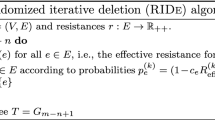Abstract
The average and worstcase performance of four Paull’s algorithms for rearranging threestage connection networks are analyzed from a reswitching number point of view. It is shown that all of the approximation algorithms behave very poorly in the most unfavorable states of the networks. However, regarding the expectation of the number of reswitchings in the thermodynamic limit, it is shown, following Bonomi et al.,that all the algorithms are probabilistically good in the sense that they almost always generate solutions which are close to the optimal ones. Finally, it is pointed out that a refinement according to which reswitchings are confined to the least loaded switches does not improve the worstcase performance of Paull’s rearrangement algorithms.
Analyse
L’auteur analyse le cas moyen et le pire des cas de fonctionnement de quatre algorithmes de Pauli pour réarranger les réseaux de connexion à trois étages du point de vue du nombre de commutations. Il montre que tous les algorithmes approchés fonctionnent mal dans les états défavorables pour le réseau. D’autre part, considérant le nombre moyen de commutations dans la limite thermodynamique, on démontre [3], que tous ces algorithmes sont satisfaisants dans un sens probabilistique, c’est-à-dire qu’ils produisent presque toujours des solutions optimales. Enfin, on démontre que le fait de limiter les commutations aux commutateurs les moins chargés, ne modifie pas le fonctionnement des algorithmes de Pauli dans le pire des cas de données.
Similar content being viewed by others
References
Bassalygo (L. A.), Grushko (I. I.) andNeiman (V. I.). The number of reswitchings for a three-stage connecting network. Proc. 6thInt. Teletraf. Conf., Munich (1970), pp. 241/1-241/5.
Benes (V. E.). Mathematical theory of connecting networks and telephone traffic.Academic Press, New York (1965).
Bonomi (E.),Lutton (J. L.) andFeix (M. R.). Threestage rearrangeable connecting networks in the thermodynamic limit: number of needed reswitchings.IEEE Trans. C, USA (Jan. 1983),COM-31, n∘ 1, pp. 110–113.
Clos (C.). A study of nonblocking switching networks.Bell Syst. Tech. J., USA (Mar. 1953),32, n∘ 2, pp. 406–424.
Hwang (F. K.). Control algorithms for rearrangeable clos networks.IEEE Trans. C., USA (Aug. 1983),COM-31, n∘ 8, pp. 952–954.
Jajszczyk (A.). Priority rearrangements. Proc. 10th.Int. Teletraf. Conf., Montreal (1983), Session 5.1.
Jajszczyk (A.),Rajski (J.). The effect of choosing the switches for rearrangements in switching networks.IEEE Trans. C, USA (Oct. 1980),COM-28, n∘ 10, pp. 1832–1834.
Kubale (M.). Worst-case analysis of some algorithms for rearranging three-stage connection networks. Proc. 9thInt. Teletraf. Conf., Torremolinos (1979), Session 34.
Paull (M. C.). Reswitching of connection networks.Bell Syst. Tech. J., USA (May 1962),41, n∘ 3, pp. 833–855.
Author information
Authors and Affiliations
Rights and permissions
About this article
Cite this article
Kubale, M. Average and worst-case performance of Paull’s algorithms for rearranging threestage connection networks. Ann. Télécommun. 40, 270–276 (1985). https://doi.org/10.1007/BF03004502
Received:
Accepted:
Issue Date:
DOI: https://doi.org/10.1007/BF03004502
Key words
- Telecommunication switching
- Switching network
- Multistage circuit
- Algorithm
- Averaging method
- Worst case
- method




